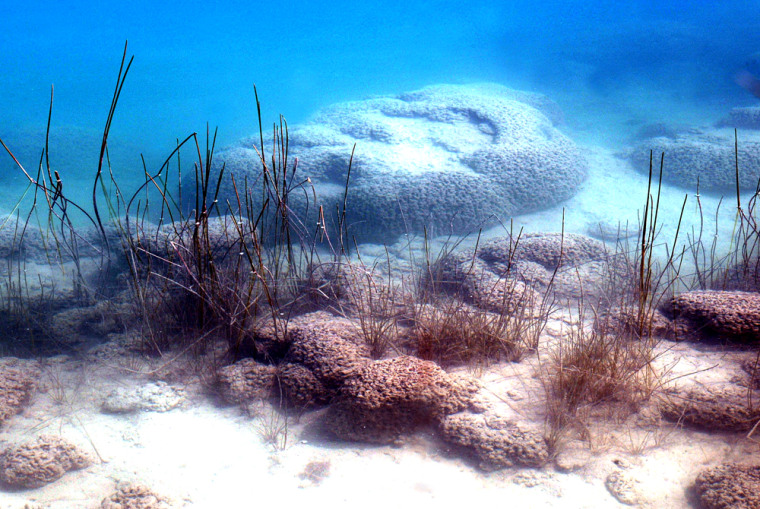With cobalt waters harboring eerie, coral-like formations, this archipelago of lakes in Mexico’s searing Chihuahuan desert has always had an otherworldly appearance.
Now, top NASA researchers say the calcified clumps of primitive bacteria lurking in its pools could provide important clues in their search for extraterrestrial life.
The network of 170 cactus-ringed lagoons around the town of Cuatro Cienegas have intrigued evolutionary biologists for decades because their fish, snail and turtle species rival the Galapagos Islands in their uniqueness.
Scientists from NASA’s Astrobiology Institute have begun studying the lakes’ ancient formations called stromatolites — rock structures formed by layers of algae that trap silt. Conditions within the stromatolites are similar to those that prevailed on Earth for more than 2 billion years before the dinosaurs evolved.
Studying their organisms could help NASA identify the unique atmospheric conditions created by primitive life on planets orbiting nearby stars and help settle the question of whether we are alone in the universe.
“They may be our best example of what to look for on other planets,” said Brad Bebout, a researcher at the NASA Ames Research Center, as he prepared to harvest methane belched out by the organisms in a shallow blue-green pool.
“Most of the time that life has been on Earth, this is what it looked like, not like the plants and animals that you see around you now,” he added.
Microbial life on Earth ... and beyond?
The stromatolites and other colonies of single-celled organisms were marooned in the pools when the sea retreated more than 100 million years ago, leaving a tantalizing glimpse of the life forms that thrived on early Earth and created an atmosphere based on oxygen.
NASA’s hunch is that planets around nearby stars could be populated by similar colonies of primitive bacteria, which served as the basis from which complex, multicellular plants and animals that inhabit the Earth later evolved.
Aided by two scuba divers, researchers have taken a range of gas readings, cell and chemical samples from the clusters of bacteria, which look like clumps of coral dropped into the parched desert.
Scientists from the institute will then use information gleaned from the samples to perfect complex computer models of atmospheric conditions suitable to life on a range of “virtual” planets.
The models will be used by astronomers armed with a powerful space-based telescope — due to be launched in the next decade — to search for the unique signs of life in atmospheres surrounding far-off planets.
“We believe, and it is only a belief at this point, that there is probably a lot of life out in the universe, but it may only be at the microbial stage,” Victoria Meadows, the institute’s virtual planetary laboratory chief, told Reuters as she watched divers entering the Poza Azul lake. “Not people flying UFOs, but nevertheless life elsewhere in the universe.”
Checking the atmospheres of other planets
Astronomers have found 145 planets beyond our solar system in the past decade. Most are thought to be lifeless gas giants like Jupiter and Saturn, although they say some planetary systems might also contain smaller, terrestrial planets like Mars and Earth.
Armed with a target list of about 200 stars that NASA plans to study in detail within 45 light-years of Earth, they have now begun honing their search for potentially life-bearing worlds.
Too far to visit with a space probe, astronomers plan to explore them using a space observatory dubbed the Terrestrial Planet Finder, which is due to be launched in 2014,
Designed to have an imaging power 100 times greater than the current Hubble Space Telescope, scientists say it will send back telling snapshots of never-before-seen planets circling far-off stars.
Astronomers plan to analyze them using a spectrometer, a machine that uses light to determine what gases are present in the planets’ atmospheres, and check it against NASA’s list of characteristics for a life-bearing world.
“We won’t be able to break the planet up into continents and oceans or waterfront real estate, but what we will see is a dot of light containing a lot of information about the atmosphere and surface,” Meadows said.
“What we are learning here at Cuatro Cienegas may help us understand it.”
Scientists are cautious when it comes to imagining life on those worlds and are reluctant to say whether it may resemble the stunning coral rock garden formations in the ponds around Cuatro Cienegas.
“Will it be like this?” NASA associate researcher Janet Siefert asks with a chuckle as she peers over the lip of one crystalline pool. “It sure would be neat if it was. I sure wish I’d get to go there.”
